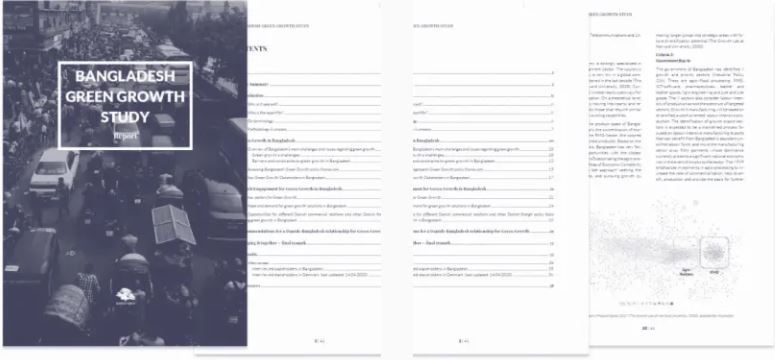The Royal Danish Embassy in Dhaka’s new strategy aspires to support shifts towards greener and more equitable outcomes of growth in Bangladesh.
The environmental and socio-economic issues and their re-enforcing dynamics in Bangladesh are immense.
Navigating this context and defining a clear strategy is difficult.
Danish humanitarian and commercial objectives demanded different, not always compatible, approaches to the new strategy of the embassy.
The study sought to understand and situate possibilities for a Danish engagement for a greener, more inclusive, and more socially responsible growth trajectory in Bangladesh.
We tried to answer a broad scope of questions through a mixed-method approach of desktop research, interviews and participatory methods such as stakeholder seminars with Danish and Bangladeshi participants. Rather than providing a collection of single analyses, we sought to meaningfully weave them together.
The inquiry was split into two tracks and the connections between them.
- The focus was on the predominant green growth challenges in Bangladesh and the subsequent needs and potential demand for adequate responses and solutions, which might present specific opportunities and entry points for a Danish engagement.
- The core strengths and competencies of Danish stakeholders and institutions on green growth as well as their existing experiences engaging in Bangladesh.
In the end, we developed a set of scenarios to paint possible pathways for action for the Danish embassy.
The study’s report provided an issue map and an overview of the barriers and constraints for green growth in Bangladesh. It established a landscape of key stakeholders, policy framework, concrete needs, demands and opportunities for green growth. We concluded by advocating for a collaborative multi-stakeholder approach and supporting the thriving social innovation ecosystem, a strategic portfolio of a variety of different types of action, and entrepreneurial models for interventions.
- Initiate and support a process that brings together multiple and different types of stakeholders together on green growth. A collaborative multi-stakeholder approachcorresponds to the expressed demand for it, the lack of such practices in Bangladesh, the level of incoherence across domains and the need for coordination.
- Integrate the embassy’s existing strategies and instruments in a directional portfolio that is focused on achieving a clear ‘joint mission’ in focused sector areas but through different available means and instruments. The strategic portfolio approach is geared towards effective change in an overwhelmingly complex and challenging context.
- Support the innovation ecosystem of pioneering non-governmental agencies and social entrepreneurship in order to enhance visibility for creative and innovative green growth solutions, support diffusion and scale of green growth solutions, increase the probability of spill-over effects and increase the innovating capabilities towards green growth in Bangladesh.
- Narrow its geographic scope to effectively concentrate efforts and resources. A potential avenue for a geographically focused approachmight be in working closely with Special-Economic Zones or secondary cities.
- Shift donor and aid-driven approaches towards entrepreneurial strategies as a pathway to strengthen Danish-Bangladesh commercial relationships.
- Continue to scout and seize arising commercial opportunities.
Additionally, three sectors and four areas of Danish expertise appeared as expedient matches: the Ready-Made Garment Sector, the Agro-Processing Sector and Energy Efficiency in Bangladesh can arguably benefit from the Danish strongholds in water and waste management and solutions, energy management and agro-food processing. The selection considered Bangladesh’s growth sectors (“going with the growth trajectory”), current existing product and knowledge space (“what is attainable”) and governmental buy-in (“what does the government wishes to achieve”)

